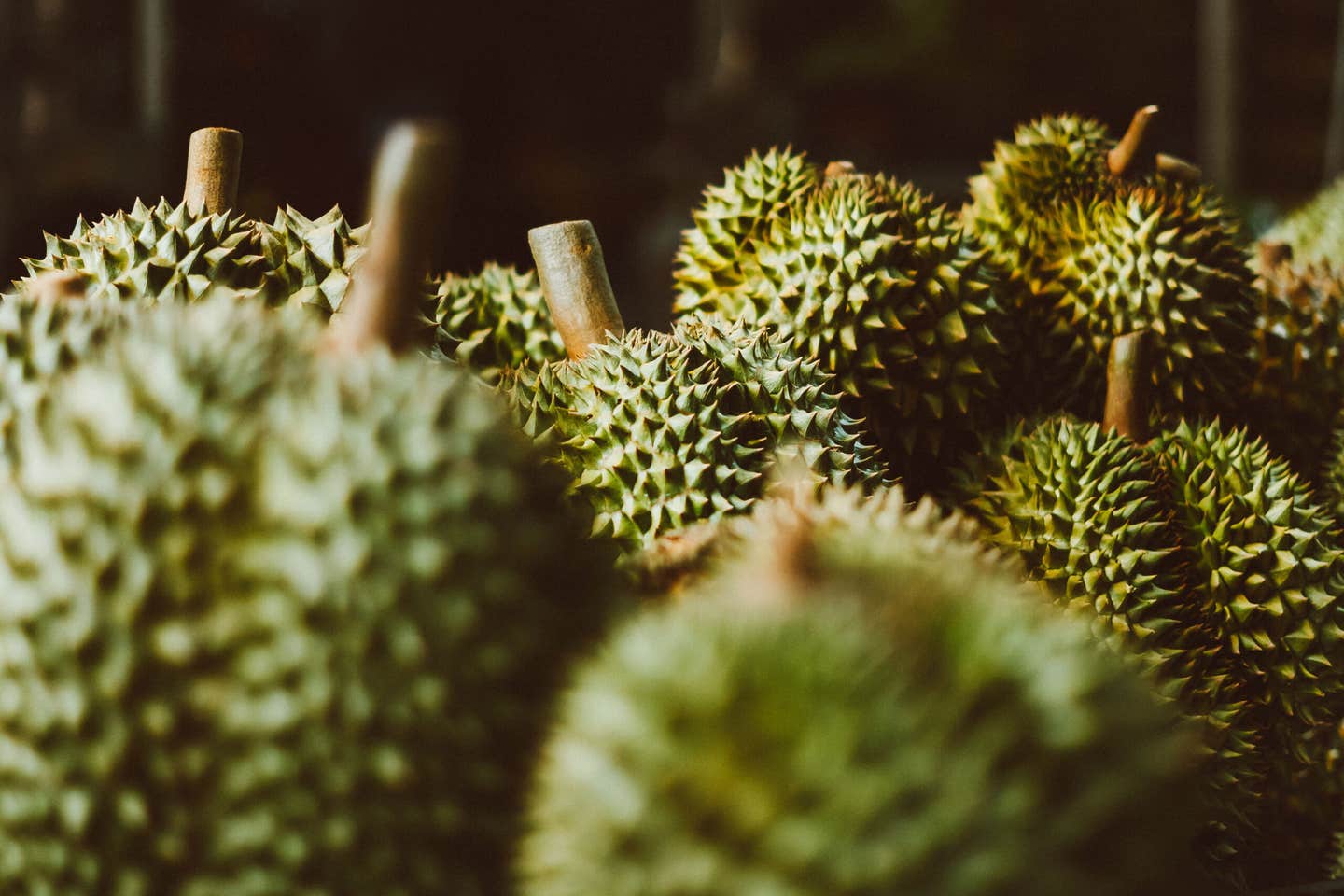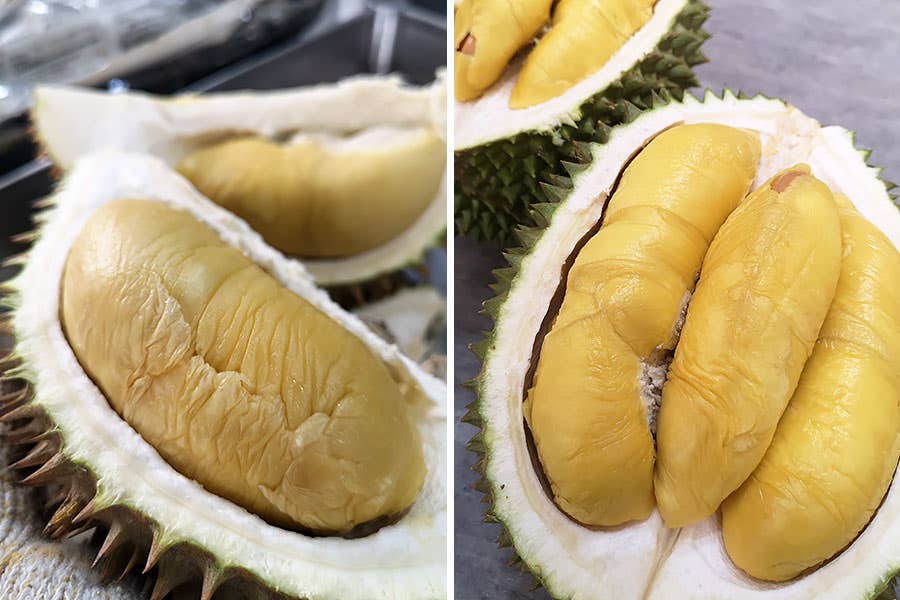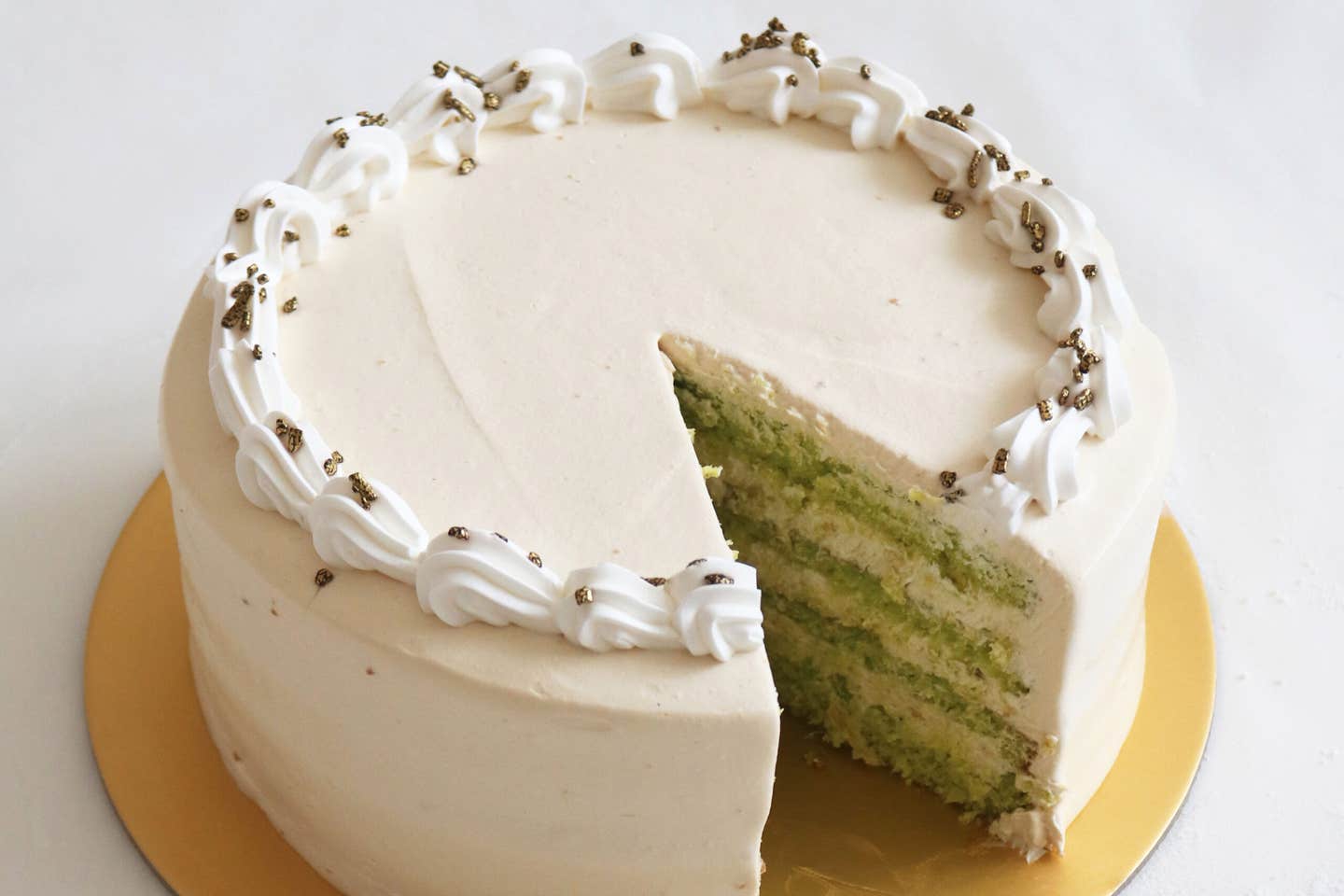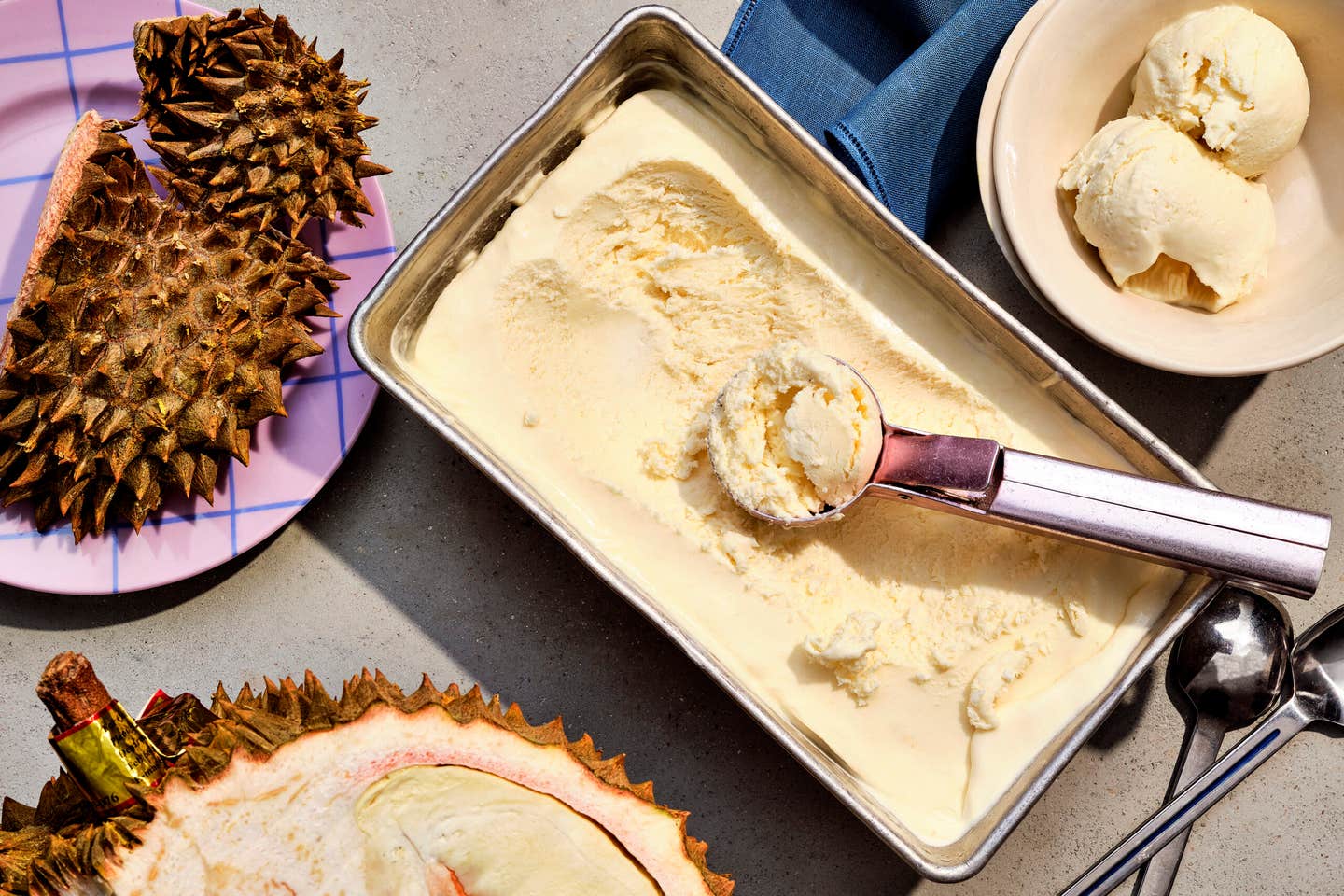
How to Choose and Cut a Durian, According to a Grower
Don’t be daunted by the spikes—this odorous tropical fruit is a sweet, creamy delicacy.
In the world of delicacy foods, few enjoy the level of fame or notoriety as the durian. Often called the “king of fruits,” the tropical ingredient inspires widespread fervor, especially in its native Southeast Asia, where it appears in countless dishes like shaved ice, cakes, cream puffs, and pizza. Even people who don’t necessarily know how to cut a durian’s famously tough outer shell are familiar with the decadence of the flesh within.
It’s hard to forget one’s first encounter with durian. When I was in middle school, I saw one on my uncle’s kitchen counter and couldn’t look away, intimidated by the huge fruit’s menacingly spiked husk. But once he cracked open the tough exterior and scooped the smooth flesh out of the hull, I sampled a small spoonful—and was spellbound. The fruit was so creamy and buttery that it tasted almost like custard. My uncle then put a portion of durian flesh into a glass container and placed it in the freezer. When we pulled it out a few hours later, the frozen fruit’s texture had become even more heavenly, akin to ice cream.

Not everyone would agree. Durian may be one of the most divisive flavors out there; the fruit has a famously strong smell stemming from odor-producing genetics, and though many find it pleasant or simply neutral (my colleague Kat Craddock aptly described it as “kind of like melon”), detractors find its fragrance off-putting at best and nauseating at worst. In fact, enough people fall into the latter camp that there are “no durian” signs posted in many mass-transit systems, hotels, and other public spaces throughout Southeast Asia.
Still, I encourage you not to be put off by any hyperbolic remarks you might hear about its scent. The smell and taste are bold and complex, and for durian lovers (like me), the fruit’s milky, custard notes prevail over its sulfurous musk.
When I visited Kelvin Tan, co-owner of the durian shop 99 Old Trees in Singapore, he taught me that not all durians are created equal, and that it takes a bit of know-how to select a specimen that is fragrant and sweet rather than overly stenchy or bitter. He also encouraged me not to be daunted by the task of cutting it open; with the right tools and some practiced precision, the reward of luscious durian flesh is well within reach. Here’s how to unlock the potential of this one-of-a-kind flavor and wrest even the spikiest fruit, based on tried-and-true guidelines from a durian pro.
What you need (materials, tools, ingredients, cooking utensils, etc.)
- large, sharp knife (like a chef’s knife or cleaver)
- thick kitchen gloves and/or tea towels
- spoon
STEP 1: Choose a cultivar.
There are many commercially cultivated varieties of durian on the market today, but Mao Shan Wang, also known as Musang King, is among the most coveted. Not only does the pulp-to-husk ratio tend to be higher than in other cultivars, the flesh is also especially creamy and sweet.
The Sultan cultivar offers a milder, more balanced flavor, with just a hint of bitterness. “Many durian connoisseurs in Singapore actually seek out this bitter taste,” notes Tan. When weather conditions are right, the flesh may even start to ferment, creating a slight alcoholic aftertaste, “like biting into tiramisu,” he adds.
Other beloved varieties include the super-sweet, orange-fleshed Red Prawn, and the dryly named D101, known for its gentle sweetness and buttery texture.
Most of the world’s durians come from Thailand and Malaysia, where the fruit is available fresh during two seasons, from June to September and from December to February. In Thailand, growers typically pluck their harvest directly from the tree, while producers in Malaysia traditionally wait for the ripe fruit to fall to the ground. Yi-Jun Loh, the Malaysia-based food writer behind the blog Jun & Tonic, suggests durian first-timers start with varieties from Thailand, which he finds to be less pungent and more floral and fruity.
If you happen to have a specialty purveyor near you, this will be the best place to find multiple cultivars and fresh, high-quality fruit. Otherwise, visit your local Asian supermarket to see if it carries durian, or order online from a fruit supplier.
STEP 2: Look for visual cues.
When selecting your durian, Tan recommends looking for specimens with green, gray, or brown husks. If the husk is starting to yellow or blacken, that’s a sign the fruit may be getting old.
It’s also crucial to identify any splits in the husk. “If there are slight hair-like cracks, those are pretty normal. But if you see big cracks, especially horizontal ones, it’s a big no-no,” explains Tan. Dark spots are another red flag, as these may be wormholes.
Another factor to keep in mind: symmetrically shaped durians tend to be easier to open.
If your local shops only carry durian pulp that has already been removed from the husk, look for a slightly wrinkled texture. “This is an indication that the fruit is fully ripe, and soft and creamy on the inside,” says Tan. On the other hand, if the surface of the pulp is smooth and “looks like a potato,” the flesh is likely to be hard, underripe, and tasteless.
STEP 3: Cut open the durian.
Once you’ve selected your durian, identify the faint lines that radiate from the base of the fruit (opposite the stem end). There are usually five seams, in a star shape, which signify where the pods of flesh inside are located. These seams are where the husk will most easily split.
Get your knife. On a flat work surface, and either wearing gloves or using a tea towel to maintain a firm grip, steady the durian with your non-dominant hand. Hold the knife in your dominant hand and, if the durian still has its stem, cut it off. Next, firmly but carefully slide the tip of the knife directly into the intersection of the seams. Once the length of the blade has penetrated about three inches, wiggle the knife gently, twisting it back and forth until the vertical seams start to split along the length of the husk. Carefully remove the knife from the fruit.
If any of the seams don’t split all the way, use your knife to slice along it, starting from the incision you just made and working your way to within a few inches of the stem.
Grip the husk on either side of the deepest fissure and pry it apart. Do the same for each split.
STEP 4: Scoop out the flesh.
You should now see big luscious mounds of durian. Use a spoon to scoop them out of the husk, then slice off and discard any imperfections or brown discolorations in the flesh. Remove and discard the seeds, and discard the husk. And voila! Durian flesh for your enjoyment.
STEP 5: Enjoy!
Once you have your durian pulp in hand, there are countless ways to eat it. If you love the raw taste, you can, of course, chow down right away. But for many, the way to durian enlightenment is to use the fruit in a decadent dessert to downplay its pungence, balancing it out with other flavors and textures. For example, try incorporating the pulp into a delicious baked good: “You can use a base recipe for banana bread, but instead of bananas, you put in durian,” suggests Loh. “That turns out really, really nice.”

To show people how versatile and lovable the ingredient can be, Tan sells an extensive dessert line-up with self-deprecating names. (I’m partial to the Stinky Bomb, a choux puff filled with durian cream, and Stinky Roll, a Swiss roll made with airy sponge cake and durian custard). Elsewhere in Singapore, the famed Chalk Farm bakery folds the pulp into burnt durian cheesecake and Durian Salat, an inspired take on the classic kueh salat (a dessert made with glutinous rice and coconut milk), while Emicakes specializes in durian-filled layer cakes and cream puffs.
Year after year, people await durian season with eagerness all across Asia, where love for the fruit is widespread and ardent. If you’re new to durian, give it a shot and you might catch on to what all the fanfare is about. Even though I love the taste of pure durian flavor, sometimes a few embellishments help mellow the fruit’s funk. That’s why I developed this no-churn durian ice cream—it’s simple and straightforward, and always reminds me of my first time tasting the king of fruits.
Recipe

Keep Reading
Continue to Next Story










